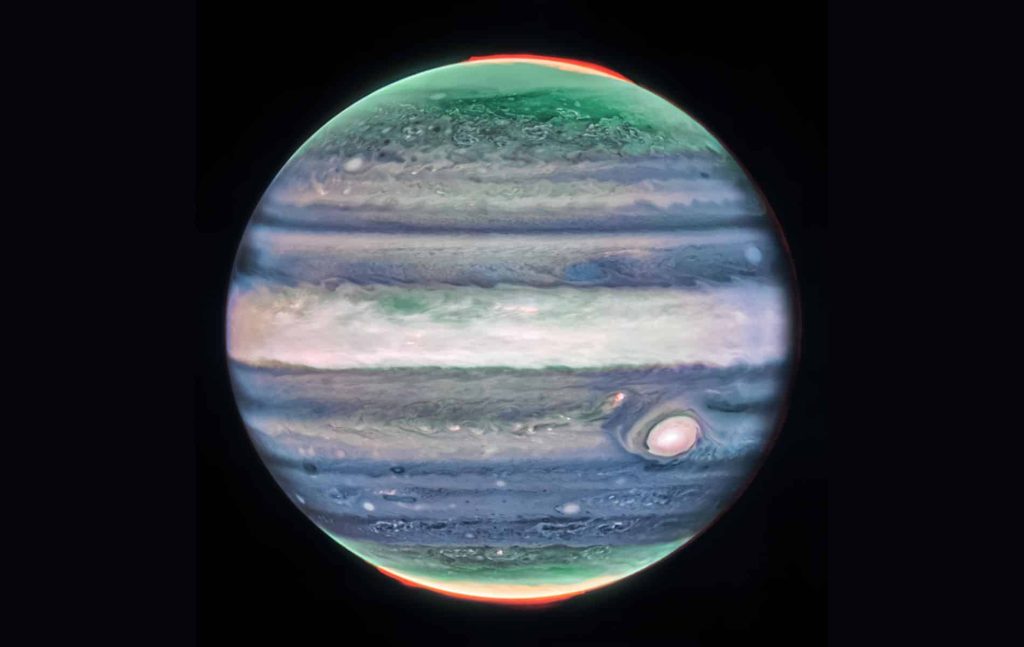Scientists have discovered a powerful jet stream blowing at a speed of about 515 kilometers per hour. That’s twice the wind speed of a Category 5 hurricane on land.
Thanks to various telescopes and space missions, you might think that Jupiter’s cloud cover no longer holds any secrets for us. For example, the Great Red Spot, which is so massive that it is large enough to cover the entire Earth, is as famous as some of the rivers and mountains on our planet. But like Earth, Jupiter is constantly changing and there is still a lot we have to learn. Fortunately, we have the James Webb Space Telescope to help us solve some of these mysteries. Now Webb has discovered something remarkable on Jupiter that has never been seen before.
Jet
In the trade magazine Nature astronomy Researchers write that Webb discovered something completely new in Jupiter’s atmosphere. It is a fast jet stream moving over the equator. The jet stream extends more than 3,000 miles (4,800 km) and lies above major cloud surfaces.
The jet stream is moving at about 515 kilometers per hour, which is twice the sustained wind speed of a Category 5 hurricane here on Earth. It is located about 40 kilometers above the clouds, in what we call Jupiter’s lower stratosphere.
Category 5 hurricane
A Category 5 hurricane is extremely powerful and is considered the strongest category on the Saffir-Simpson hurricane intensity scale. Category 5 hurricanes have wind speeds of 155 mph or higher. They cause significant damage, including devastating damage from wind, floods and storms. The impact of a Category 5 hurricane can be extremely devastating to communities and infrastructure in the storm’s path. Picture this: the recently discovered jet stream currently hitting Jupiter is twice as powerful!
Although the jet stream is not as eye-catching or impressive as some of Jupiter’s other features, this discovery provides insight into how layers of the famously turbulent atmosphere interact with each other. Furthermore, this discovery highlights the unique ability of the Webb Telescope to observe these types of features.
surprised
The researchers are amazed by their discovery. “This is something that completely surprised us,” says researcher Ricardo Hueso. “What were previously just blurry patches in Jupiter’s atmosphere now appear as distinct features that we can track.”
Discovery
Researchers discovered the jet stream after analyzing data collected by Webb’s NIRCam camera (Near infrared camera) in July 2022. This was done in the context of Early release scienceA program that aims to take images of Jupiter at 10-hour intervals, the equivalent of one day on the gas giant. The team used four different filters, each capable of detecting changes in small features at different altitudes in the atmosphere. “While many ground-based telescopes, spacecraft such as Juno and Cassini, and the Hubble Space Telescope have contributed to our understanding of the changing weather patterns in the Jovian system, the Webb telescope has already rapidly provided new information about Jupiter’s rings, moons, planets, and atmosphere,” notes researcher Emke de Pater.
Infrared
This mainly relates to Webb’s acute infrared vision. The Webb telescope sees farther than ever before in the near-infrared range and can observe the upper layers of Jupiter’s atmosphere, 25 to 50 kilometers above the top of the clouds. In near-infrared images, these upper layers typically appear faint, with a brighter area above the equator. However, using the Webb telescope we can observe more detailed features within this bright but hazy region. This confirms the added value of the space telescope. “It’s amazing that even after many years of observing Jupiter from different observatories, we can still discover new things about this planet,” says team member Lee Fletcher. “The fact that features like this jet stream were able to remain hidden until new NIRCam images are taken in 2022 is remarkable.”
The researchers are looking forward to further observations of Jupiter using the Webb telescope to see if the speed and height of the jet stream change over time. “Although Jupiter has a complex but predictable pattern of winds and temperatures in the equatorial stratosphere, there is a possibility that the strength of this new jet stream is related to the oscillating stratospheric pattern,” explains Fletcher. “As a result, the jet stream could change dramatically over the next two to four years. It will be really interesting to see if this theory is confirmed in the coming years.”

“Coffee buff. Twitter fanatic. Tv practitioner. Social media advocate. Pop culture ninja.”










More Stories
Which can cause an increase in nitrogen.
The Central State Real Estate Agency has no additional space to accommodate Ukrainians.
The oystercatcher, the “unlucky national bird,” is increasingly breeding on rooftops.